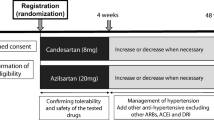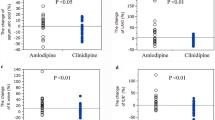Abstract
Introduction: β-Blockers have been shown to be effective in the treatment of both arterial hypertension and heart failure. However, slow titration of β-blockers over several weeks and rigorous supervision are essential to minimise antiadrenergic adverse effects in patients with heart failure. α1-Blockers are well tolerated and effectively lower blood pressure by reducing peripheral resistance.
Patients and methods: This study assessed changes in left ventricular function and quality of life in hypertensive patients with mild heart failure treated with enalapril and furosemide combined with a β-blocker with peripheral vasodilating activity (carvedilol) or an α-blocker (doxazosin), over a 1-year period. Sixty patients aged 45–65 years with untreated essential arterial hypertension and mild heart failure were randomised to receive enalapril + furosemide in combination with carvedilol or doxazosin.
Results: In the carvedilol compared with the doxazosin group, ejection fraction diminished significantly (38% vs 42%, p < 0.05) and quality of life worsened significantly (Minnesota Living Heart Failure score 54 vs 47, p < 0.05) during the first 3 weeks of treatment. Ejection fraction and quality of life had significantly improved from baseline in both groups by 12 months.
Conclusion: Doxazosin in combination antihypertensive therapy rapidly improves clinical status and haemodynamics in hypertensive patients with mild heart failure by reducing afterload. After 1 year, doxazosin and carvedilol improve clinical and haemodynamic parameters.











Similar content being viewed by others
References
Levy D, Larson MG, Vasan RS, et al. The progression from hypertension to congestive heart failure. JAMA 1996; 275: 1557–62
Chobanian AV, Bakris GL, Black HR, et al. The seventh report of the Joint National Committee on Prevention, Detection, Evaluation, and Treatment of High Blood Pressure: the JNC 7 report. JAMA 2003; 289: 2560–72
European Society of Hypertension-European Society of Cardiology Guidelines Committee. 2003 European Society of Hypertension-European Society of Cardiology guidelines for the management of arterial hypertension. J Hypertens 2003; 21: 1011–53
Zanchetti A. What have we learned and what haven’t we from clinical trials on hypertension? In: Laragh JH, editor. Hypertension: pathophysiology, diagnosis, and management. Philadelphia (PA): Lippincott Williams & Wilkins, 1995: 2509–29
Veterans Administration Cooperative Study Group on Antihypertensive Agents. Effects of treatment on morbidity in hypertension: results in patients with diastolic blood pressures averaging 115 through 129 mm Hg. JAMA 1967; 202: 1028–34
Hansson L, Lindholm LH, Niskanen L, et al. Effect of angiotensin-converting-enzyme inhibition compared with conventional therapy on cardiovascular morbidity and mortality in hypertension: the CAptopril Prevention Project (CAPPP) randomised trial. Lancet 1999; 353: 611–6
Yusuf S, Sleight P, Pogue J, et al. Effects of an angiotensin-converting-enzyme inhibitor, ramipril, on cardiovascular events in high-risk patients: the Heart Outcomes Prevention Evaluation Study investigators. N Engl J Med 2000; 342: 145–53
Psaty BM, Smith NL, Siscovick DS, et al. Health outcomes associated with antihypertensive therapies used as first-line agents: a systematic review and meta-analysis. JAMA 1997; 277: 739–45
Tepper D. Frontiers in congestive heart failure: effect of metoprolol CR/XL in chronic heart failure. Metoprolol CR/XL randomised intervention trial in congestive heart failure (MERIT-HF). Congest Heart Fail 1999; 5: 184–5
Packer M, Coats AJ, Fowler MB, et al. Effect of carvedilol on survival in severe chronic heart failure. N Engl J Med 2001; 344: 1651–8
CIBIS Investigators and Committees. A randomized trial of beta-blockade in heart failure: the Cardiac Insufficiency Bisoprolol Study (CIBIS). CIBIS Investigators and Committees. Circulation 1994; 90: 1765–73
Packer M, Bristow MR, Cohn JN, et al. The effect of carvedilol on morbidity and mortality in patients with chronic heart failure: US Carvedilol Heart Failure Study Group. N Engl J Med 1996; 334: 1349–55
Young RA, Brogden RN. Doxazosin: a review of its pharmacodynamic and pharmacokinetic properties, and therapeutic efficacy in mild or moderate hypertension. Drugs 1988; 35: 525–41
Nash DT. Alpha-adrenergic blockers: mechanism of action, blood pressure control, and effects of lipoprotein metabolism. Clin Cardiol 1990; 13: 764–72
Fulton B, Wagstaff AJ, Sorkin EM. Doxazosin: an update of its clinical pharmacology and therapeutic applications in hypertension and benign prostatic hyperplasia [published erratum appears in Drugs 1995; 49: 554]. Drugs 1995; 49: 295–320
Davey MJ. Pharmacologic basis for the use of doxazosin in the treatment of essential hypertension. Am J Med 1989; 87(2A): 36S–44S
Babamoto KS, Hirokawa WT. Doxazosin: a new alpha 1-adrenergic antagonist. Clin Pharm 1992; 11: 415–27
Lewis CE, Grandits A, Flack J, et al. Efficacy and tolerance of antihypertensive treatment in men and women with stage 1 diastolic hypertension: results of the treatment of mild hypertension study. Arch Intern Med 1996; 156: 377–85
McTavish D, Campoli-Richards D, Sorkin EM. Carvedilol: a review of its pharmacodynamic and pharmacokinetic properties, and therapeutic efficacy. Drugs 1993; 45: 232–58
Dunn CJ, Lea AP, Wagstaff AJ. Carvedilol: a reappraisal of its pharmacological properties and therapeutic use in cardiovascular disorders. Drugs 1997; 54: 161–85
Guyatt GH, Sullivan MJ, Thompson PJ, et al. The 6-minute walk: a new measure of exercise capacity in patients with chronic heart failure. CMAJ 1985; 132: 919–23
Executive summary of the Third Report of the National Cholesterol Education Program (NCEP) Expert Panel on Detection, Evaluation, and Treatment of High Blood Cholesterol in Adults (Adult Treatment Panel III). JAMA 2001; 285: 2486–97
Hjalmarson A, Goldstein S, Fagerberg B, et al. Effects of controlled-release metoprolol on total mortality, hospitalizations, and well-being in patients with heart failure: the Metoprolol CR/XL Randomized Intervention Trial in congestive heart failure (MERIT-HF). MERIT-HF Study Group. JAMA 2000; 283: 1295–302
Randomised, placebo-controlled trial of carvedilol in patients with congestive heart failure due to ischaemic heart disease: Australia/New Zealand Heart Failure Research Collaborative Group. Lancet 1997; 349: 375–80
Haas JG. Vasodilators. In: Hosenpud JD, Greenberg BH, editors. Congestive heart failure: pathophysiology, diagnosis and comprehensive approach to management. New York: Springer-Verlag, 1994: 400–53
Cohn JN, Johnson G, Ziesche S, et al. A comparison of enalapril with hydralazine-isosorbide dinitrate in the treatment of chronic congestive heart failure. N Engl J Med 1991; 325: 303–10
ALLHAT Officers and Coordinators for the ALLHAT Collaborative Research Group. Major cardiovascular events in hypertensive patients randomized to doxazosin vs chlorthalidone: the antihypertensive and lipid-lowering treatment to prevent heart attack trial (ALLHAT). JAMA 2000; 283: 1967–75
Antihypertensive and Lipid-Lowering Treatment to Prevent Heart Attack Trial Collaborative Research Group. Diuretic versus alpha-blocker as first-step antihypertensive therapy: final results from the Antihypertensive and Lipid-Lowering Treatment to Prevent Heart Attack Trial (ALLHAT). Hypertension 2003; 42: 239–46
Davis BR, Cutler JA, Furberg CD, et al. Relationship of antihypertensive treatment regimens and change in blood pressure to risk for heart failure in hypertensive patients randomly assigned to doxazosin or chlorthalidone: further analyses from the Antihypertensive and Lipid-Lowering treatment to prevent Heart Attack Trial. Ann Intern Med 2002; 137(5 Pt 1): 313–20
Mancia G. The ALLHAT study: contributions, limitations and prospectives [in Italian]. Ital Heart J 2003; 4(2 Suppl.): 77–84
Sica DA. Doxazosin and congestive heart failure. Congest Heart Fail 2002; 8: 178–84
Levy D, Walmsley P, Levenstein M. Principal results of the Hypertension and Lipid Trial (HALT): a multicenter study of doxazosin in patients with hypertension. Am Heart J 1996; 131: 966–73
DiBianco R, Parker JO, Chakko S, et al. Doxazosin for the treatment of chronic congestive heart failure: results of a randomized double-blind and placebo-controlled study. Am Heart J 1991; 121(1 Pt 2): 372–80
Jimenez-Garcia R, Anegon M, Esteban J, et al. Safety and effectiveness of replacing standard doxazosin with doxazosin in the gastrointestinal therapeutic system (GITS) formulation in elderly hypertensive patients. Int J Clin Pract 2003; 57: 267–72
Ebbs D. A comparison of selected antihypertensives and the use of conventional vs ambulatory blood pressure in the detection and treatment of hypertension. Cardiology 2001; 96Suppl. 1: 3–9
Os I, Stokke HP. Effects of doxazosin in the gastrointestinal therapeutic system formulation versus doxazosin standard and placebo in mild-to-moderate hypertension: Doxazosin Investigators’ Study Group. J Cardiovasc Pharmacol 1999; 33: 791–7
Daae LN, Westlie L. A 5-year comparison of doxazosin and atenolol in patients with mild-to-moderate hypertension: effects on blood pressure, serum lipids, and coronary heart disease risk. Blood Press 1998; 7: 39–45
Acknowledgements
We thank Michele Malena, Managing Director, for Hesperia Hospital support. The authors have no conflicts of interest that are directly relevant to the content of this study.
Author information
Authors and Affiliations
Corresponding author
Rights and permissions
About this article
Cite this article
Zacà, F., Benassi, A., Bolzani, R. et al. Comparative Effects of Doxazosin and Carvedilol on Clinical Status and Left Ventricular Function in Hypertensive Patients with Mild Heart Failure. High Blood Press Cardiovasc Prev 12, 37–44 (2005). https://doi.org/10.2165/00151642-200512010-00006
Published:
Issue Date:
DOI: https://doi.org/10.2165/00151642-200512010-00006




